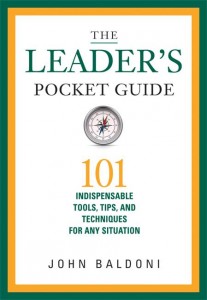If you are a student of leadership, you will likely know the name John Baldoni. His manybooks including Lead With Purpose, Lead Your Boss, How Great Leaders Get Great Results and Lead By Example all line the bookshelves of my office. If you somehow missed all of his books on leadership, you may have read his work in publications such as Inc.com, Fast Company, Forbes, CBSNews/MoneyWatch, Bloomberg/Businessweek, and Harvard Business Review, the Wall Street Journal or the Washington Post.
 What I like most about John’s work is that it is practical. I can put his advice to use immediately. His latest book is The Leader’s Pocket Guide: 101 Indispensable Tools, Tips, and Techniques for Any Situation.
What I like most about John’s work is that it is practical. I can put his advice to use immediately. His latest book is The Leader’s Pocket Guide: 101 Indispensable Tools, Tips, and Techniques for Any Situation.
John, this pocket guide seems to distill so much of your work in bite-sized tips. What motivated you to write this pocket guide?
This book is the result of my work with executives I have coached over the past decade or so. As I say in the dedication to the book, my impact on them has been small but their impact on me has been large.
You start the book with self-leadership, then move to working with colleagues and finally an entire organization. Why is self-leadership always the starting point?
One cannot lead others without leading oneself. So where does that begin? With self-awareness and self-understanding. So often I work with executives who are capable leaders and are giving to others but they end up shorting themselves. This section focuses on things to do to develop your critical thinking, awareness and presence. All are critical to leadership.
Would you share one of your tips with us and tell us more about it? Maybe share a story of how you saw its application in your coaching practice?
Leadership presence is something I coach regularly. Presence is the window to a leader’s character that he or she shows to others. Consider it the real you, the authentic self. Presence gives people a reason to believe in your leadership and follow your lead. It is a summation of your competence, credibility and confidence. Presence is developed and reinforced by words, but mostly by example. It is the ability to connect authentically with others. Strong leadership presence inspires trust.
What do you see as the primary role of a leader?
A leader must bring people together for common cause. That means he or she must find common ground and then bring people to it by creating the vision, ensuring alignment, and developing the team to achieve. It requires strong communication and the ability to execute and follow through.
What is one characteristic you look for in leaders?
 Resilience. Warren Bennis once wrote that most leaders he knew had experienced adversity but had come through the experience much stronger. I agree. No shame in getting knocked down. It is what you do next that matters most. I work with leaders who may have missed a big promotion, led a failed project or maybe been terminated from a job. All bounced back stronger for it. The experience made them more humble as well as wiser and they are more capable leaders.
Resilience. Warren Bennis once wrote that most leaders he knew had experienced adversity but had come through the experience much stronger. I agree. No shame in getting knocked down. It is what you do next that matters most. I work with leaders who may have missed a big promotion, led a failed project or maybe been terminated from a job. All bounced back stronger for it. The experience made them more humble as well as wiser and they are more capable leaders.
What habits can a leader develop to encourage growth as a leader?
Good question. I don’t know if it is a habit or not, but perhaps the ability to recognize your strengths as well as your shortcomings. In that effort a good leader will surround him or herself with people who will speak up, or speak truth to power if you will. Such leaders are humble as well as vulnerable. At the same time good leaders are decisive and when things need to be done, they act with deliberate speed, and most important, they bring people along with them.
If you missed my previous interview with John, you can view it here.

